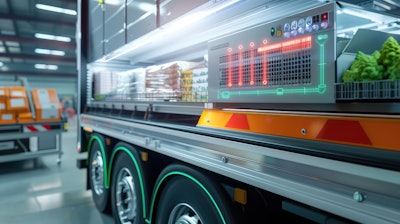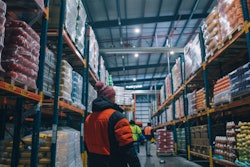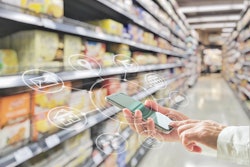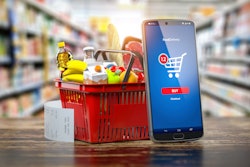
The global grocery industry represents a complex ecosystem worth over $864 billion in 2025, serving as the critical link between agricultural producers and consumers worldwide. This vast network faces unprecedented challenges: supply chain disruptions, labor shortages, sustainability demands, and evolving consumer expectations for speed and convenience. In response, the industry is experiencing a technological revolution that promises to reshape how food moves from farm to table.
Traditional grocery supply chains, characterized by linear, centralized distribution models, are giving way to sophisticated networks powered by artificial intelligence, robotics, and innovative production methods. These advancements are not merely incremental improvements but reimagining how food systems can operate more efficiently, sustainably, and resiliently in an increasingly complex global marketplace.
The digital transformation of grocery supply chains
Artificial intelligence and predictive analytics. The integration of AI across grocery supply chains represents one of the most significant technological advances in recent years. Modern computing technologies now provide real-time access to actionable data with enhanced granularity, enabling unprecedented supply chain optimization. Leading retailers have pioneered AI-driven demand forecasting systems that can predict consumer needs with remarkable accuracy, reducing waste and ensuring product availability.
AI applications extend beyond simple inventory management. Machine learning algorithms analyze weather patterns, seasonal trends, local events, and historical purchasing data to optimize everything from crop planning to final-mile delivery routes. This predictive capability enables grocers to maintain optimal stock levels while minimizing food waste, a critical concern in an industry where approximately 30% of food produced globally is lost or wasted.
Robotic automation in distribution centers. The grocery industry has embraced robotic automation at an unprecedented scale. Leading retailers have automated numerous distribution centers and are deploying autonomous systems for inventory management, order fulfillment, and warehouse operations. Modern robotic systems can handle delicate items with precision while excelling at repetitive tasks such as sorting, packing, and inventory management, allowing human workers to focus on higher-value activities requiring creativity and problem-solving skills.
The economic impact of automation is substantial. Recent multi-million dollar investments in AI robotics platforms demonstrate the industry's commitment to technological transformation. These investments are driving efficiency gains that translate directly to improved customer experiences through faster delivery times and reduced costs.
Hyperlocal production and distributed manufacturing
Micro-factory revolution. One of the most exciting innovations reshaping grocery supply chains is the emergence of hyperlocal food systems. For example, localized manufacturing through autonomous micro-factories can produce and process food and beverages on-site, locally, but at a quickly replicable, global scale. This distributed manufacturing model fundamentally challenges traditional centralized production approaches.
These micro-factories can decentralize production or packaging, eliminating middle-mile transportation costs and emissions while building resilient food supply chains. For consumers, this means fresher products with reduced environmental impact. For retailers, it offers greater supply chain control and reduced vulnerability to global disruptions.
Vertical integration and local sourcing. The hyperlocal movement extends beyond manufacturing to encompass vertical farming, local sourcing initiatives, and community-supported agriculture programs. Major grocery chains are increasingly investing in local producer networks, reducing dependence on long-distance transportation and creating more sustainable supply chains.
This trend toward localization offers multiple benefits: reduced carbon footprint, enhanced food safety through shorter supply chains, support for local economies, and increased resilience against global supply disruptions. The COVID-19 pandemic highlighted the vulnerabilities of global supply chains, accelerating adoption of more distributed and localized food systems.
Data integration and supply chain visibility
Real-time supply chain management. Modern grocery supply chains generate vast amounts of data across every touchpoint from farm to consumer. The true opportunity lies in integrating supplier data with core business systems, including ERP, inventory, and order management platforms. Forward-thinking distributors recognize that robust data exchange is essential for real-time decision-making and optimization.
This integration enables end-to-end supply chain visibility, allowing retailers to track products from origin through final sale. Advanced analytics platforms can identify bottlenecks, predict disruptions, and automatically adjust operations to maintain optimal performance. The result is more responsive supply chains that can adapt quickly to changing conditions.
Blockchain and traceability. Blockchain technology is revolutionizing food traceability, enabling complete visibility into product origins, handling, and distribution. This technology addresses growing consumer demands for transparency while providing critical capabilities for food safety management. When foodborne illness outbreaks occur, blockchain-enabled traceability systems can identify affected products within minutes rather than days, minimizing health risks and economic impact.
Sustainability and environmental impact
Emissions reduction through optimization. The grocery industry faces increasing pressure to reduce its environmental footprint. Advanced supply chain technologies are proving instrumental in achieving sustainability goals. AI-optimized routing reduces transportation emissions, while predictive analytics minimize food waste by ensuring products reach consumers before spoilage.
Companies are no longer merely focused on efficiency; they are embracing sustainable practices as integral components of their supply chain strategies. This shift reflects both regulatory requirements and consumer preferences for environmentally responsible retailers.
Circular economy principles. Leading grocery retailers are implementing circular economy principles throughout their supply chains. This includes packaging optimization, waste reduction programs, and closed-loop systems that convert waste products into valuable resources. Advanced analytics enable optimization of these circular processes, maximizing resource utilization while minimizing environmental impact.
Challenges and future outlook
Labor and workforce transformation. The technological transformation of grocery supply chains presents both opportunities and challenges for workforce development. While automation reduces demand for certain types of manual labor, it creates new opportunities in technology management, data analysis, and system optimization. The industry must invest in workforce retraining and development to ensure workers can transition successfully to new roles.
Supply chain resilience. The supply chain landscape of 2024 demands agility, resilience, and foresight from businesses. Recent global disruptions have highlighted the importance of building flexible supply chains capable of adapting to unexpected challenges. Technology plays a crucial role in creating this resilience through diversified sourcing, predictive analytics, and automated response systems.
Integration challenges. Despite the promise of new technologies, integration remains a significant challenge for many grocery retailers. Legacy systems, data silos, and organizational resistance can impede technological adoption. Successful transformation requires comprehensive change management strategies that address both technical and cultural barriers.
Conclusion
The grocery supply chain is experiencing a period of unprecedented innovation and transformation. AI, robotics, hyperlocal production systems, and advanced data analytics are creating more efficient, sustainable, and resilient food distribution networks. These technologies address critical industry challenges while opening new possibilities for serving consumers better.
The retailers and suppliers that successfully embrace these innovations will gain significant competitive advantages through improved efficiency, reduced costs, enhanced sustainability, and superior customer experiences. However, this transformation requires substantial investments in technology, workforce development, and organizational change management.
As we look toward the future, the grocery supply chain will likely become increasingly automated, localized, and data-driven. The companies that navigate this transformation successfully will be those that view technology not as a replacement for human capabilities but as a tool for enhancing and augmenting human potential while creating more sustainable and equitable food systems for all.
The revolution in grocery supply chains represents more than technological advancement—it signifies a fundamental reimagining of how society produces, distributes, and consumes food. The innovations emerging today will shape the food systems of tomorrow, creating a more resilient, efficient, and sustainable foundation for global food security.



















